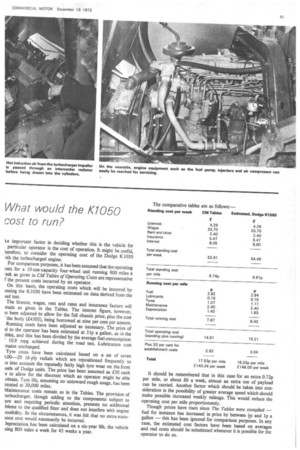What would the K1050 cost to run?
Page 53

If you've noticed an error in this article please click here to report it so we can fix it.
kn important factor in deciding whether this is the vehicle for . particular operator is the cost of operation. It might be useful, herefore, to consider the operating cost of the Dodge K1050 pith the turbocharged engine. For comparison purposes, it has been assumed that the operating osts for a 10-ton-capacity four-wheel unit running 800 miles a reek as given in CM Tables of Operating Costs are representative I the present costs incurred by an operator. On this basis, the operating costs which will be incurred by inning the K1050 have been estimated on data derived from the rad test.
The licence, wages, rent and rates and insurance factors will main as given in the Tables. The interest figure, however, Ls been adjusted to allow for the full chassis price, plus the cost the body (L4303), being borrowed at nine per cent per annum. Running costs have been adjusted as necessary. The price of el to the operator has been estimated at 31p a gallon, as in the Lbles, and this has been divided by the average fuel consumption ' 10.9 mpg achieved during the road test. Lubrication cost mains unchanged.
Tyre costs have been calculated based on a set of seven 1.00-20 16-ply radials which are repositioned frequently to te into account the reputedly fairly high tyre wear on the front [eels of Dodge units. The price has been assumed as £50 each t to allow for the discount which an operator might be able obtain. Tyre life, assuming no untoward rough usage, has been imated at 30,000 miles.
Maintenance costs remain as in the Tables. The provision of turbocharger, though adding to the components subject to ure and requiring periodic attention, presents no additional iblems to the qualified fitter and does not interfere with engine :essibility. In the circumstances, it was felt that no extra mainance cost would necessarily be incurred. )epreciation has been calculated on a six-year life, the vehicle fling 800 miles a week for 45 weeks a year. It should be remembered that in this case for an extra 0.72p per mile, or about £6 a week, almost an extra ton of payload can be carried. Another factor which should be taken into consideration is the possibility of greater average speed which should make possible increased weekly mileage. This would reduce the operating cost per mile proportionately. Though prices have risen since The Tables were compiled fuel for instance has increased in price by between fp and lp a gallon this has been ignored for comparison purposes. In any case, the estimated cost factors have been based on averages and real costs should be substituted whenever it is possible for the operator to do so.




































































































